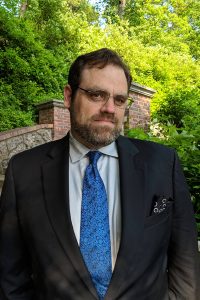Matthew Davis was a Lecturer in the Department of English and Cultural Studies and the Co-Coordinator of the Digital Arts and Humanities program at UBCO from 2021-2025. His research investigates the connections between embodiment, gender, and technology in place, space, and religious practice in pre-modern material, textual, and performance cultures.
Davis received his PhD in English literature (with a certificate in Digital Humanities) from Texas A&M University in 2013. Before coming to UBCO, he was a ZKS-Lendrum Assistant Professor (Research) in the Scientific Study of Manuscripts and Inscriptions at the University of Durham for 2022, a postdoctoral fellow at the Ruth and Lewis Sherman Centre for the Digital Scholarship at McMaster University, a Lindsey Young Visiting Faculty Fellow at the University of Tennessee’s Marco Institute for Medieval and Renaissance Studies, and the Council of Library and Information Resources/Mellon Fellow in Data Curation for Medieval Studies at North Carolina State University.
Dr. Davis shared some insights on his research and teaching practices here at UBC Okanagan.
Tell us about your research interests and what excites you about your field of work
My research investigates the connections between embodiment, gender, and technology in place, space, and religious practice in pre-modern material, textual, and performance cultures. The goal there is to tease out what I call semiotic palimpsests–elements of the ways people thought about themselves in the late medieval and early Tudor periods that have been lost or suppressed due to the expectations of people in subsequent centuries. This means I’m primarily concerned with the cultural contexts works are produced within, their relationship to contemporary ideas, and the lives of the people who produced and consumed them.
I liken what I do to a form of literary archaeology; there’s the general study of literature qua literature, of course, but beyond that there’s insights to be gained about medieval culture and in the case of drama, how these works might have been put into practice in a real, ephemeral moment of performance. That sort of sense that the medieval should be allowed to stand as it’s own thing and not as part of or in opposition to something else seems to largely be missing today. We live in an incredibly presentist time; everything is focused on the eternal now and things are often taken out of context and put to work to shore up our beliefs, whether for good or ill. I see the broad goal of my work in the middle ages to be in some ways an act of decolonization; not, in this case, of settlers colonizing indigenous lands but of the present colonizing the past and taking from it what they find useful.
How did you know you wanted to be a professor?
I started out working on a degree in International Relations with the original goal of wanting to join the Foreign Service in the United States. About two years into that program I decided that the life of a Foreign Service Officer, where you change locations every three years, wasn’t conducive to building a life. Which is a bit ironic, considering my post-degree pinballing around the world, but nevertheless that was my thinking.
Once I’d made that decision, I needed to figure out what I did want to do with my life. I was sitting in a computer lab on my undergrad campus when it struck me that what I really wanted to do was talk about ideas. That’s the thing that most excites me, and the job that seemed most likely to let me do that as a major part of my job was to be a professor.
What kind of learning experiences do offer your students
It depends on the course I’m teaching, obviously, but in general a student in my courses can expect to encounter what the digital world calls “Critical Making” and what might more broadly be considered experiential learning.
For my digital courses like the ones I’m teaching here at UBCO, I am a big believer in learning-by-doing and failure being built into the learning process. Much of the work in my class is trying out various digital tools and methods while I talk to students one-on-one or in small groups. I see my goal in these courses to make students aware that these tools exist and to give them a basic understanding of how they function under the hood. If it turns out that the tool or method has use for them they can explore it further, but knowing the tool is available in their metaphorical tool-chest is what I hope they get out of the courses I teach here.
